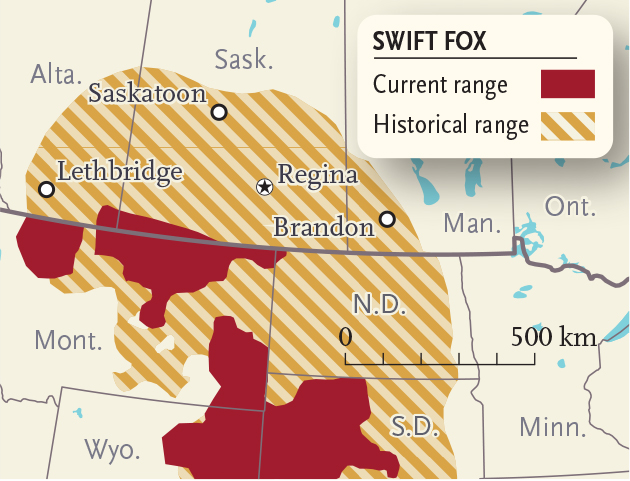Map: Chris Brackley/Canadian Geographic. Map credit: “Historical Range, Current Distribution and Conservation Status of the Swift Fox, Vulpes Velox, in North America.» Canadian Field-Naturlaist 123(4): 346–367, by Marsha A. Sovada, Robert O. Woodward and Lawrence D. IGL, 2009.
The swift fox is the smallest wild dog in North America and among the smallest in the world — at two to three kilograms, it’s about as heavy as an adult Chihuahua — but it’s one of the biggest wildlife recovery stories.
Once abundant across short- and mixed-grass prairies in Alberta, Saskatchewan and Manitoba, the speedy predator, which can hit 60 kilometres per hour on the run, started to disappear in the late 1800s as a result of the rise of large-scale agriculture and the subsequent loss of habitat. Inadvertent poisoning by farmers targeting agricultural pests, such as prairie dogs, ground squirrels, wolves and coyotes, added to the swift fox’s woes. By 1938 it was extirpated in Canada.
The nocturnal canid disappeared for almost half a century. Then beginning in 1983, a few wild-born and captive-raised swift foxes from the United States were reintroduced to southeastern Alberta and southern Saskatchewan. They thrived, and with the help of local communities, further reintroductions and modern monitoring techniques, had reached an estimated 650 foxes in Canada by 2006, with hundreds more living in nearby Montana.
Ironically, if the swift fox’s success turns to excess, it could pose a real danger to the recovery of the greater sage-grouse, of which there are fewer than 150 remaining in Canada. Luckily, this predator–prey juggling act has so far been relatively balanced. Today the swift fox’s greatest threats include habitat degradation from industrial development and road construction. Under Canada’s Species at Risk Act, the swift fox is currently classified as a threatened species, but the population is now considered stable, with almost all pups being born in the wild.






